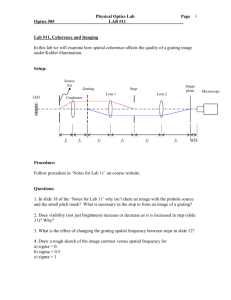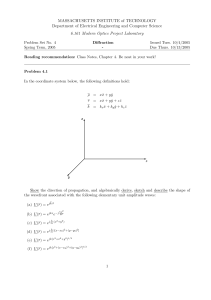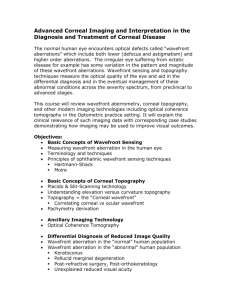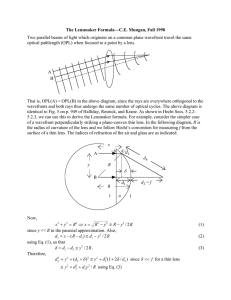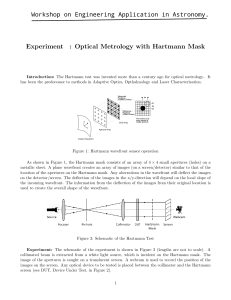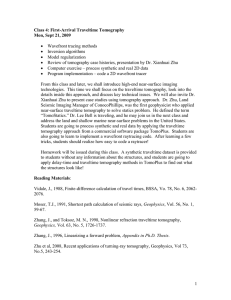MASSACHUSETTS INSTITUTE of TECHNOLOGY
advertisement
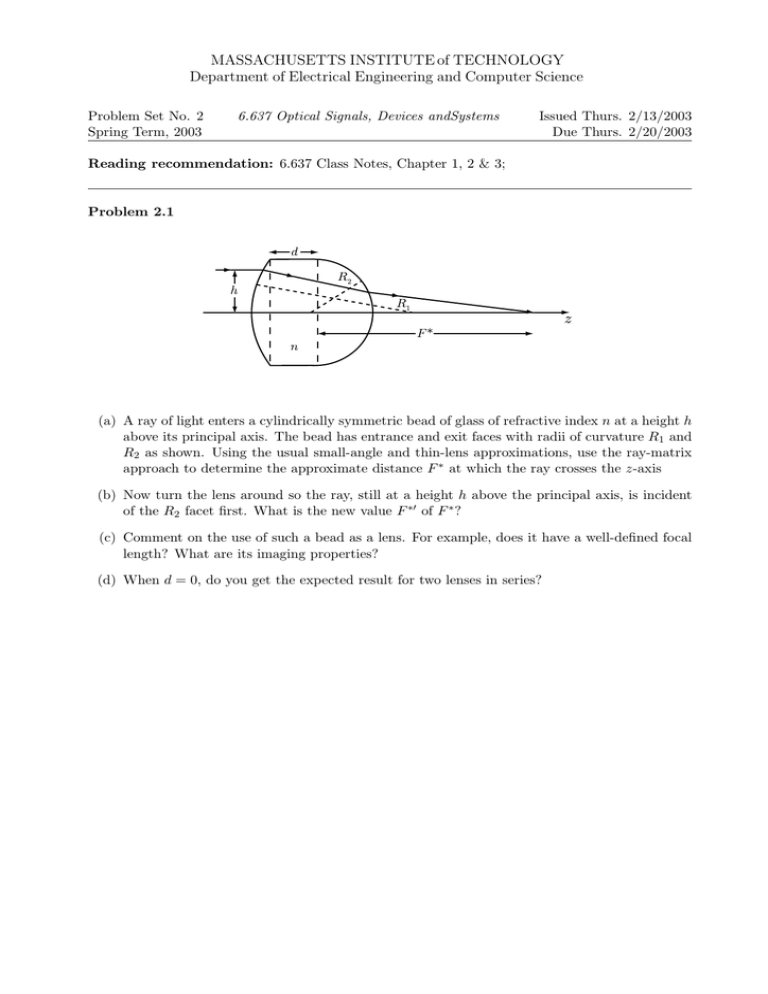
MASSACHUSETTS INSTITUTE of TECHNOLOGY Department of Electrical Engineering and Computer Science Problem Set No. 2 Spring Term, 2003 6.637 Optical Signals, Devices andSystems Issued Thurs. 2/13/2003 Due Thurs. 2/20/2003 Reading recommendation: 6.637 Class Notes, Chapter 1, 2 & 3; Problem 2.1 � �� � �� � �� � (a) A ray of light enters a cylindrically symmetric bead of glass of refractive index n at a height h above its principal axis. The bead has entrance and exit faces with radii of curvature R1 and R2 as shown. Using the usual small-angle and thin-lens approximations, use the ray-matrix approach to determine the approximate distance F ∗ at which the ray crosses the z-axis (b) Now turn the lens around so the ray, still at a height h above the principal axis, is incident of the R2 facet first. What is the new value F ∗ of F ∗ ? (c) Comment on the use of such a bead as a lens. For example, does it have a well-defined focal length? What are its imaging properties? (d) When d = 0, do you get the expected result for two lenses in series? Problem 2.2 The figure below is the plot of a piecewise-continuous, one-dimensional crossection through a 2-D wavefront of wavelength λ. The normal to the wavefront segments all lie in the x − z plane, and the wavefront is travelling nominally in the +z-direction. All segments of the 2-D wavefront are of the same area (10λ × 10λ) and they all carry the same power density I Watt/m2 . � �λ �λ � λ (a) Write a frequency-domain expression, U (fx , fz ), that represents this wavefront. (b) Sketch the spatial-frequency content of this wavefront on a graph with the co-ordinate system shown below. (c) The wavefront passes through a lens of focal-length F (not shown). Sketch the intensity pattern that would be seen on a screen placed in the back focal plane of the lens, and label the positions and the sizes of any critical features that will be present in the intensity pattern on the screen. � �� �� Problem 2.3 Consider the following three, infinitely-long one-dimensional, deformable grating mirrors (mirror surface with variable d) with the surface profiles shown below. The mirrors are illuminated at normal incidence (along the z-axis) with a plane wave of wavelength λ. �������� ����� � � ���� Λ ���� � (i) square-wave grating profile �������� ����� � ���� � ���� Λ � (ii) right-triangular grating profile �������� ����� � ���� � Λ ���� � (iii) isosceles-triangular grating profile For each of the cases above: (a) Write an expression φ(x) for the phase imparted by the mirror on the wave. (b) Using inspection techniques, what minimum value of d do you think will extinguish the zeroorder diffracted light (justify your answer with physical arguments). (c) Derive an expression for the far-field intensity diffracted into the mth order as a function of d. (d) Using the results from part (c), what is the value of d that extinguishes the zero-order light? (e) Design a 2-D intensity spatial light modulator that employs one of these basic structures. In a spatial light modulator each pixel is independently addressable. Performance criteria include: contrast ratio, IIon , spatial resolution (# of pixels per unit area), operating voltage, off operating current or power, capacitance or inductance, modulation speed (of one element), framing speed (of the entire array), complexity of the addressing scheme, spatial uniformity of response, number of bits of grayscale, etc. Explain why or how you arrived at your design in the context of the above criteria. What are the strengths of your design? What are the weaknesses of your design?
